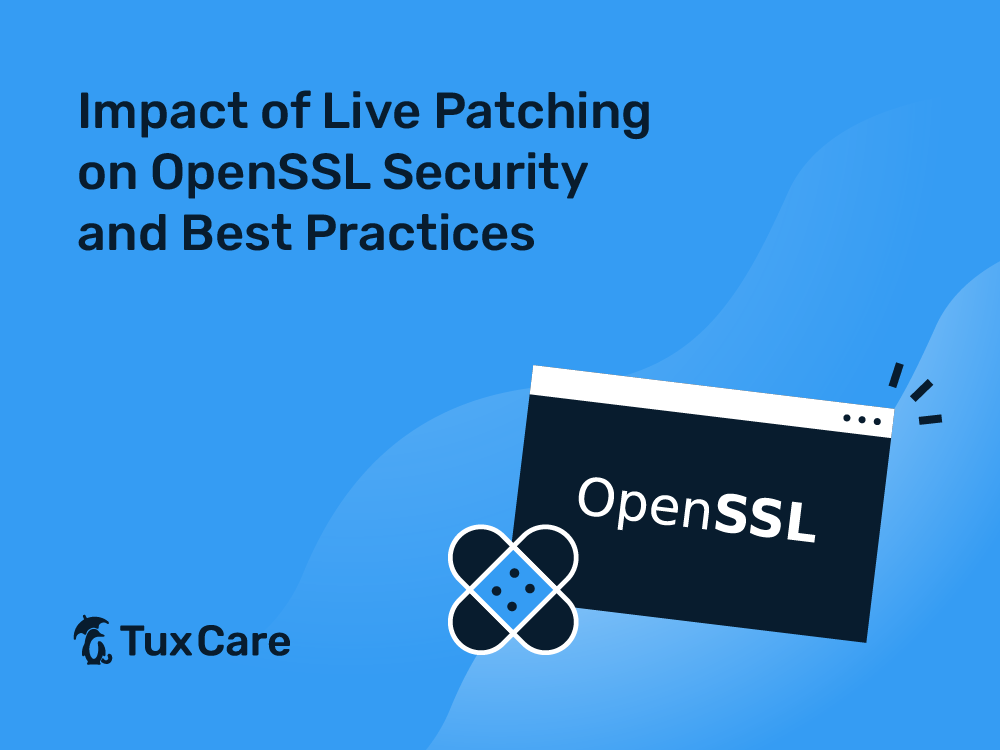The Impact of Live Patching on OpenSSL Security and Best Practices
- Live patching allows for updating OpenSSL without system reboots – reducing downtime and maintaining service availability.
- While live patching improves security by enabling faster updates, careful planning and implementation are crucial.
- Best practices include risk assessment, tool selection, and thorough testing in a staging environment before deployment.
Like any other software library, OpenSSL is susceptible to security vulnerabilities that can pose significant risks to systems and data if left unaddressed. Therefore, keeping OpenSSL patched is crucial, but traditional patching often requires significant downtime – a risky proposition for mission-critical systems. This is where live patching comes in as a solution, removing the downtime involved and patching the system while it is still running. In this article, we’ll analyze how live patching affects the security of OpenSSL and explore best practices for implementing live patching on OpenSSL.
What Is OpenSSL?
OpenSSL is a general-purpose cryptography library that provides an open-source implementation of the Secure Sockets Layer (SSL) and Transport Layer Security (TLS) protocols. SSL and TLS are cryptographic protocols designed to provide communication security over a computer network, with SSL being a predecessor to TLS. OpenSSL is utilized in various applications, including web servers, email servers, VPNs, etc., to secure web browsers, email, instant messaging, and other data transfers.
Importance of Security in OpenSSL
The security of internet-facing systems is of paramount importance. A breach in security and the data it holds may have disastrous consequences for individuals and organizations. For instance, having access to an email server can have far-reaching effects. A few potential problems include the theft of personal email content, the ability to masquerade as an employee, getting spammed, and being a spam relay.
OpenSSL vulnerabilities could lead to denial of service attacks that can consume server resources, preventing access for legitimate users. Furthermore, attackers could exploit buffer overflows or other vulnerabilities to escalate privileges or steal sensitive data. In order to prevent such attacks, it has become increasingly important to be able to apply patches to systems promptly with minimum disruption.
Explore popular security threats in OpenSSL and learn how to stay secure against evolving threats here.
The Impact of Live Patching on OpenSSL Security
With live patching, administrators can apply patches to a running system without needing to reboot or disrupt its operation. This is especially advantageous for mission-critical systems that cannot afford to be taken offline for patching, such as servers hosting important services like web applications or databases.
By adopting live patching on OpenSSL, organizations can enjoy various benefits like:
No Reboot or Downtime
Live patching enables the deployment of security patches without having to reboot or interrupt services. Organizations can ensure continuous protection against emerging threats without compromising uptime.
A Reduced Vulnerability Window
Conventional patching techniques often require a reboot or scheduled downtime for installation, leaving systems exposed until the patches can be applied. Employing live patching on OpenSSL reduces this vulnerability window, thus minimizing the amount of time that systems are exposed to known vulnerabilities.
Automated Patching
Some live patching tools, like LibCare, provide automated vulnerability patching for OpenSSL. Security updates are applied automatically without manual intervention, reducing the possibility of human errors or missing patches.
Best Practices for Implementing Live Patching on OpenSSL
Planning
Vulnerability Assessment: It is essential to identify OpenSSL vulnerabilities that affect your OpenSSL version and require patching. Another important thing to consider is prioritizing them based on the risk they pose to your system. This means the critical vulnerabilities having a higher impact should be patched first.
Live Patching Tool: Tools like LibCare offer live patching services for OpenSSL. LibCare can be used as an add-on tool to KernelCare Enterprise, a live Linux kernel patching tool. KernelCare Enterprise supports all major Linux distributions, including Ubuntu, Debian, CentOS, RHEL, Rocky Linux, AlmaLinux, CloudLinux, Oracle Linux, Amazon Linux, and more. LibCare is also compatible with these Linux distros.
Rollback Strategy: Having a clear rollback plan is recommended in case the implementation of live patching on OpenSSL introduces unforeseen issues in the system.
Testing
Staging Environment: Test patches in a non-production or staging environment that mirrors the production environment. This is useful in identifying issues and resolving them before deploying to the production environment.
Security Scans: After applying the live patch in the test environment, perform a thorough security scan to ensure the patch itself hasn’t introduced new vulnerabilities. Consider engaging with security experts or conducting penetration testing to validate the effectiveness of the patches.
Deployment
Phased Rollout: Consider using a phased deployment strategy, starting with a limited set of systems. Monitor system performance and security metrics during and after patch deployment to detect any anomalies or issues.
Documentation: Maintain detailed documentation of the entire process, including the used tool, testing procedures and results, applied patches, and rollback plan. This documentation will be very helpful for audits and ensures seamless patching in the future.
Final Thoughts
By following these best practices, you can leverage the benefits of live patching while minimizing the security risks to your OpenSSL implementation. Also, it is essential to stay informed about security advisories and maintain regular updates to enhance the overall security of systems using OpenSSL.
Live patching on OpenSSL is particularly important for critical systems that cannot afford downtime. With the LibCare live patching tool, you can receive additional benefits, like automation, deployment assistance, and tech support.
If you have any questions about OpenSSL live patching, ask us a question and one of our OpenSSL security experts will get back to you.



 Documentation
Documentation Login
Login




